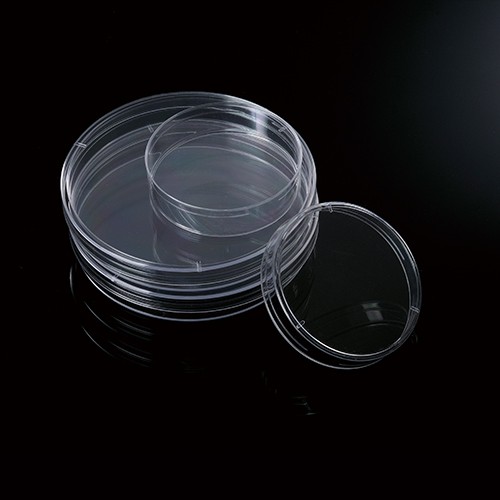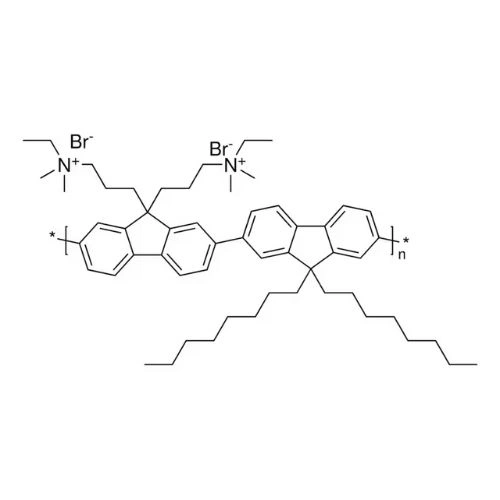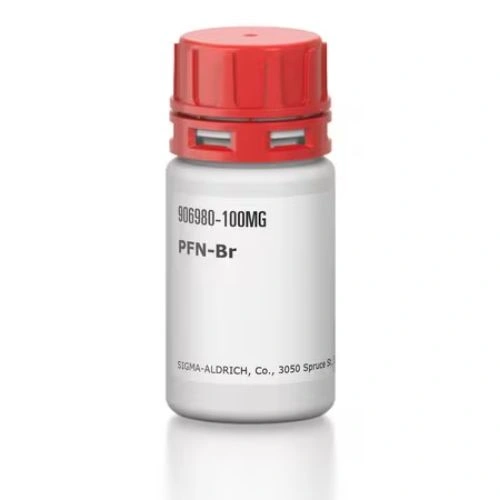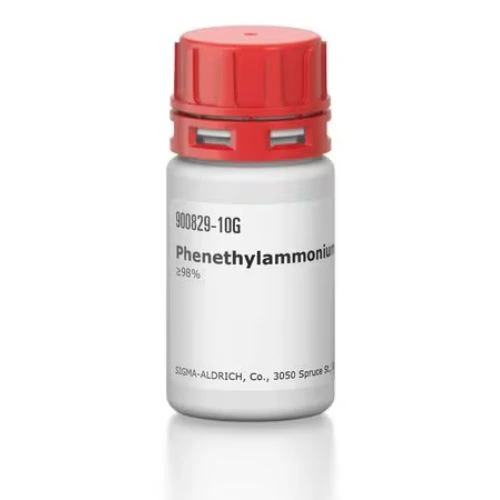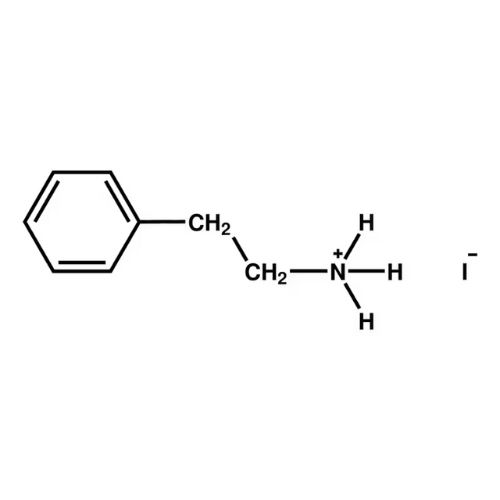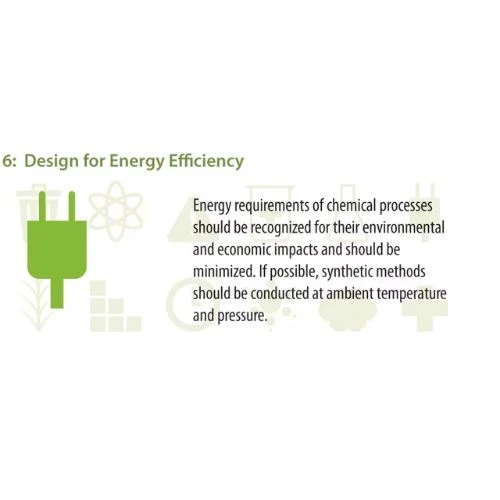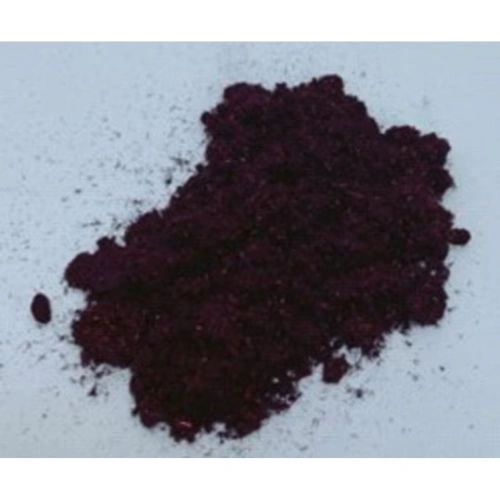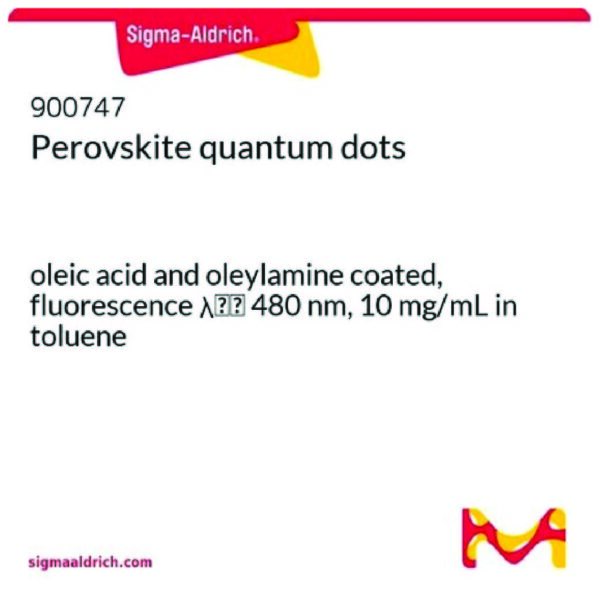
Perovskite quantum dots oleic acid and oleylamine coated, fluorescence λem 480 nm, 10 mg/mL in toluene – Sigma-Aldrich
RM934.00Brand:
Sigma-Aldrich
Synonyms
Cadmium free QDs, Fluorescent nanocrystals, Perovskite nanocrystals, QDs
Applications
For Perovskite quantum dots:
Perovskite quantum dots (QDs) of common formula CsPbX3 (X = Cl, Br, I) possess high photoluminescence efficiency and narrow emission and emit in the visible spectral regime. Perovskite QDs are cadmium free and the aforementioned properties render them suitable for applications in light emitting diodes (LEDs), lasers, liquid crystal displays (LCDs) etc.
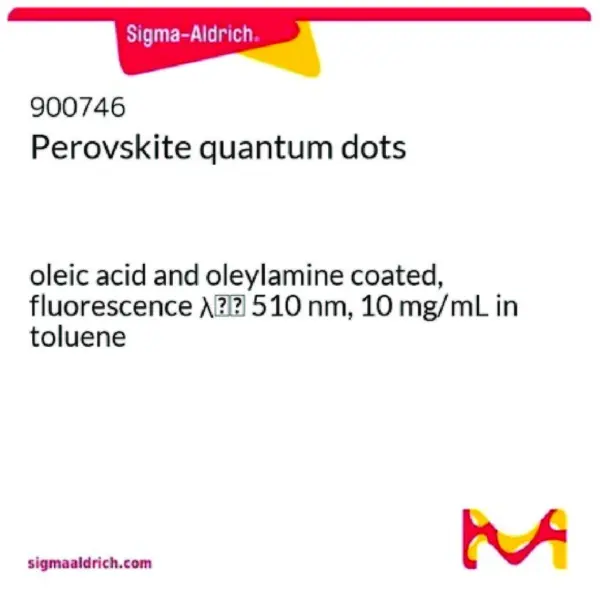
Perovskite quantum dots oleic acid and oleylamine coated, fluorescence λem 510 nm, 10 mg/mL in toluene – Sigma-Aldrich
RM2,108.00Brand:
Sigma-Aldrich
Synonyms
Cadmium free QDs, Fluorescent nanocrystals, Perovskite nanocrystals, QDs
Applications
For Perovskite quantum dots:
Perovskite quantum dots (QDs) of common formula CsPbX3 (X = Cl, Br, I) possess high photoluminescence efficiency and narrow emission and emit in the visible spectral regime. Perovskite QDs are cadmium free and the aforementioned properties render them suitable for applications in light emitting diodes (LEDs), lasers, liquid crystal displays (LCDs) etc.
Petri Dishes
RM0.00Brand:
Biologix
Characteristics
● Made of medical-grade polystyrene; High degree of transparency for optimal analysis by microscopy
● Three sizes available with uniform thickness and smooth surface
● Vented lid for better gas exchange; Easy stacking
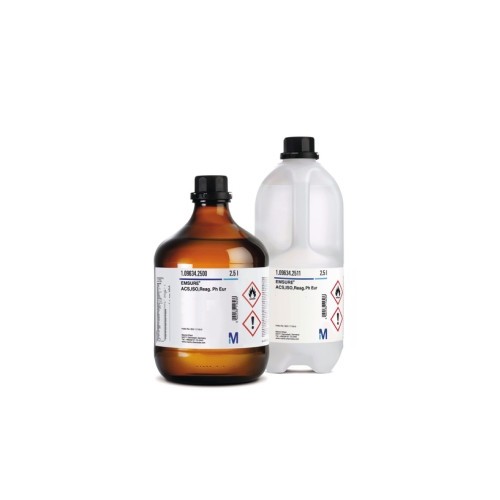
Petroleum benzine for analysis boiling range 40-60°C EMSURE® ACS,ISO (Merck)
Price range: RM80.00 through RM163.00Brand:
Merck
Description
CAS number: 64742-49-0
Chemical Formula: –
Molar Mass: –
Synonyms: –
EMSURE® grade solvents are suitable for a broad spectrum of classical lab applications and are frequently used in regulated and highly demanding lab applications. EMSURE® provides worldwide best and most extensive product specifications. We declare our EMSURE® range to be in compliance with the ACS, with the reagent part of the European Pharmacopoeia (Reag. Ph Eur) and also with the ISO standards.
Product Specification and MSDS for Petroleum benzine EMSURE® (Merck).
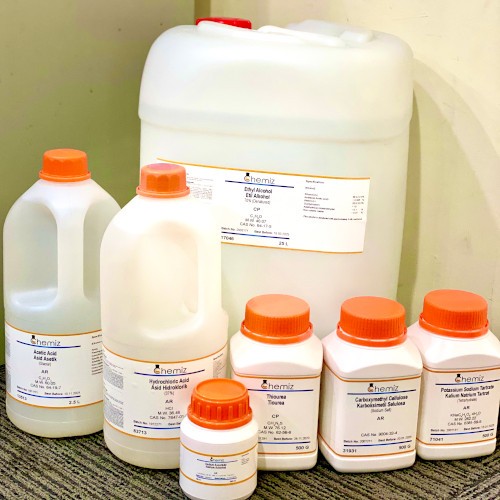
Petroleum ether 40°C-60°C AR, 2.5L
RM87.00Brand:
Chemiz
Description
Formula: C6H14
Analytical grade petroleum ether for laboratory uses as solvent and extraction solvent.
Note:
AR: Analitycal Reagent Grade: Reagents for analytical purpose or research work that need high purity.
CP: Chemically Pure Grade: Reagents for regular practical in its original purity.
PFN-Br – Sigma-Aldrich
RM1,862.00Brand:
Sigma-Aldrich
Synonyms
OS0995, PFN-P2, Poly(9,9-bis(3’-(N,N-dimethyl)-N-ethylammoinium-propyl-2,7-fluorene)-alt-2,7-(9,9-dioctylfluorene))dibromide
Cas No.
889672-99-5
General description
We are committed to bringing you Greener Alternative Products, which adhere to one or more of The 12 Principles of Greener Chemistry. This product belongs to Enabling category of greener alternatives thus aligns with “Design for energy efficency”. Electron transport organic materials have the chemical functionality to transport electrons and are used as electron transport layer in OLED devices. Click here for more information.
Application
PFN-Br is a solution processible, conjugated polymer electrolyte used as interficial layer in high performance organic photovoltaic cells (OPV) and organic light emitting diodes (OLED) to improve the interfacial properties.
OPV devices with PFN-Br interfacial layer showed overall enhanced short-circuit current density, open-circuit voltage, fill factor and corresponding high efficiency in the inverted OPVs. This was attributed to the good contact between ZnO electron extraction layer and the active layer, good interface adhesion between the electron extraction layer and active layer, and enhanced charge transport via suppressed bimolecular recombination.
Recent report of OPV with a record energy conversion efficiency of 17.3% also utilized PFN-Br, spin-coated on top of ZnO to improve the interfacial properties.
Tandem Cell Device performance:
ITO/ZnO/PFN-Br/PBDB-T:F-M/M-PEDOT/ZnO/PTB7- Th:O6T-4F:PC71BM/MoO3/Ag
Voc=1.642 V
Jsc=14.35 mA/cm2
FF=73.7%
PCE=17.3%
PFN-Br finds application in a wide range of areas:
- OPV interficial layer (metalic oxide compact layer)
- OLED electron transport layer
- Perovskite solar cells
- Flexible printed electronics
- Cationic polymer electrolyte
- Anion exchange material
- Light emitting electrochemical cells
Other Notes
Recommend to use 0.2 mg/ml concentration for electron-transport interfacial layer in OPV.

pH-Indicator Strips, MQuant® (Merck)
Price range: RM129.00 through RM135.00Brand:
Merck
Description
The MQuant® pH tests are suited for all media in environmental analysis and in industrial in-process controls. Our special method of manufacture gives the pH indicator strips decisive advantages over the indicator paper: since the indicator does not bleed, the strip can be left in the measurement medium without contaminating it. Using these test strips is fairly easy, the pH value is measured semiquantitatively by visual comparison of the reaction zone on the test strip with the fields of the color scale, perfectly matching the reaction color. The clever Safetyedge boxes allow for safe storage and convenient withdrawal of the test strips. For tests for other parameters that require a specific pH range of the sample (e.g. Spectroquant®, see instructions of use), we recommend the use of MQuant® pH test strips as pre-test.
Product Specification and MSDS for MQuant® pH Indicator Strips (Merck).
Phenethylammonium bromide, ≥98% – Sigma-Aldrich
Price range: RM437.00 through RM848.00Brand:
Sigma-Aldrich
Synonyms
Greatcell Solar®, Phenethylamine hydrobromide
Cas No.
53916-94-2
General description
We are committed to bringing you Greener Alternative Products, which adhere to one or more of The 12 Principles of Greener Chemistry. This product has been enhanced for energy efficiency. Click here for more details.
Application
Organohalide based perovskites have emerged as an important class of material for solar cell applications. Our perovskites precursors are useful for synthesizing mixed cation or anion perovskites needed for the optimization of the band gap, carrier diffusion length and power conversion efficiency of perovskites based solar cells.
Legal Information
Product of Greatcell Solar Materials Pty Ltd.
Greatcell Solar is a registered trademark of Greatcell Solar Materials Pty Ltd.
Greatcell Solar is a registered trademark of Greatcell Solar
Phenethylammonium iodide – Sigma-Aldrich
RM1,280.00Brand:
Sigma-Aldrich
Synonyms
Greatcell Solar®, Phenethylamine hydriodide
Cas No.
–
General description
We are committed to bringing you Greener Alternative Products, which adhere to one or more of The 12 Principles of Greener Chemistry. This product has been enhanced for energy efficiency. Click here for more details.
Application
The iodide and bromide based alkylated halides find applications as precursors for fabrication of perovskites for photovoltaic applications.
Legal Information
Product of Greatcell Solar Materials Pty Ltd.
Greatcell Solar® is a registered trademark of Greatcell Solar Materials Pty Ltd
Greatcell Solar is a registered trademark of Greatcell Solar
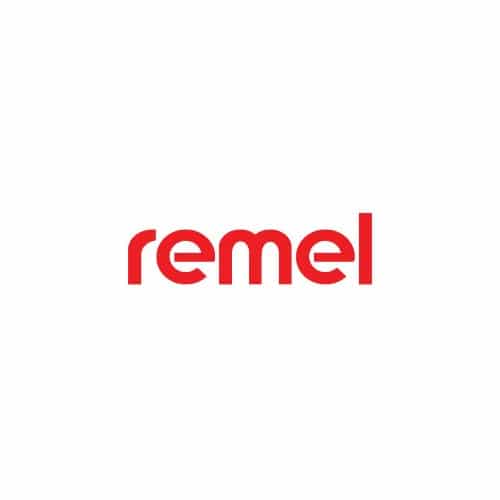
Phenol Red Solution BTL/25ml
RM246.00Brand:
Thermo Scientific™ Remel™
Thermo Scientific™ Remel Phenol Red Solution is a pH indicator for use with microbiological culture media.
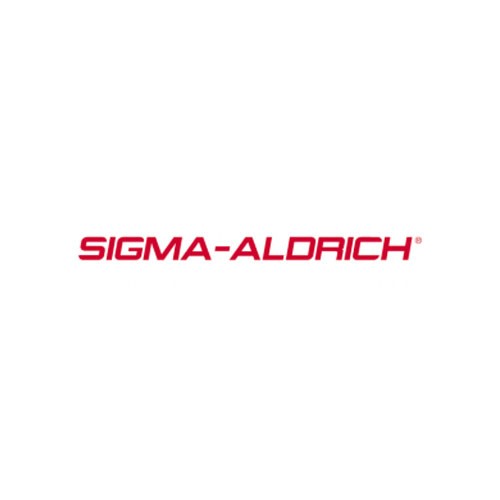
Phorbol 12-myristate 13-acetate, ≥99% (TLC, Sigma-Aldrich)
RM678.00Brand:
Sigma-Aldrich
Description
CAS number: 16561-29-8
Chemical Formula: C36H56O8
Molar Mass: 616.83g/mol
Synonyms: 12-O-Tetradecanoylphorbol 13-acetate, 4β,9α,12β,13α,20-Pentahydroxytiglia-1,6-dien-3-one 12-tetradecanoate 13-acetate, PMA, TPA
General description
Phorbol 12-myristate 13-acetate is a phorbol ester. It works as a tumour promoter and is involved in gene transcription, cell growth, differentiation, programmed cell death, immune pathway and receptor desensitization via protein kinase C (PKC) signalling pathways. Phorbol 12-myristate 13-acetate is also a model agent to study growth factors-, hormones-, and cytokines-mediated regulation of cellular growth and differentiation.
Application
Phorbol 12-myristate 13-acetate has been used for the stimulation of various cells including spleen cells, quiescent lymphocytes and fetal thymocytes. It has also been used for the activation of PKC (protein kinase C) in cells.
Solubility
DMSO: soluble (Dissolve in water-miscible organic solvent prior to preparing aqueous solutions. DMSO solutions can be stored dark at -20 °C for at least six months.)
Ethanol: soluble (Dissolve in water-miscible organic solvent prior to preparing aqueous solutions.)
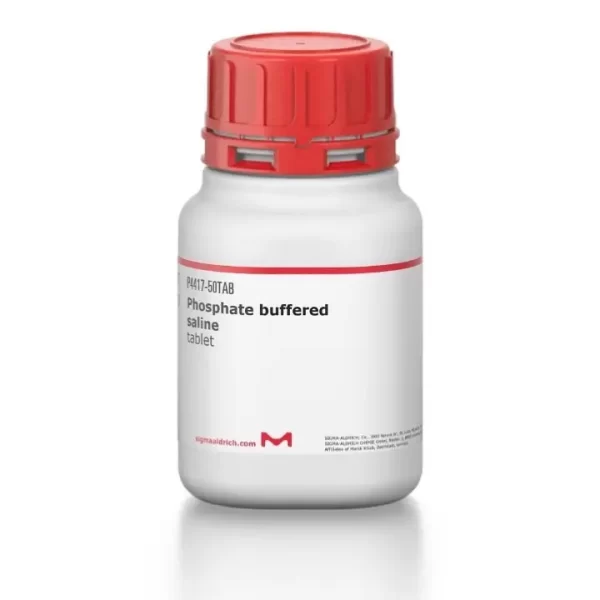
Phosphate buffered saline (Sigma-Aldrich)
Price range: RM588.00 through RM1,001.00Brand:
Sigma
Description
CAS Number : 24867-26-3
Phosphate-buffered saline (PBS) is a buffer solution used in biological research. It is a water-based salt solution containing sodium phosphate, sodium chloride and, in some formulations, it contains potassium chloride and potassium phosphate. The osmolality and ion concentrations of the solutions match those of the human body (isotonic) and are non-toxic to most cells.
Application :
- For the production of platinum nanoparticles (NP-Pt) hydrocolloids
- For the washing of blood sample and SEM (scanning electron microscope) stubs prior to SEM
- For preparing the solution of fluorescent lectin wheat germ agglutinin (WGA)
- For the dilution of capture antibody during ELISA (enzyme linked immunosorbent assay)
- For suspension of cell pellets during centrifugation
- In immunoassay procedures.
One tablet dissolved in 200 mL of deionized water yields 0.01 M phosphate buffer, 0.0027 M potassium chloride and 0.137 M sodium chloride, pH 7.4, at 25 °C.

Phosphate Buffered Saline Powder, pH 7.4, For Preparing 1 L solutions, Sigma
RM57.00Brand:
Sigma-Aldrich
Application
• Phosphate buffered saline has been used in the washing solutions during immunofluorescence procedure.
• It has been used for the suspension of bacterial cells.
• It has been used during the fixation and immunostaining procedures.
Reconstitution
Contents of one pouch, when dissolved in one liter of distilled or deionized water, will yield 0.01 M phosphate-buffered saline (NaCl 0.138 M; KCl – 0.0027 M); pH 7.4, at 25 °C.

Phosphate Buffered Saline Tablets (PBS), Oxoid
RM180.00Brand:
Thermo ScientificTM OxoidTM
Phosphate Buffered Saline Tablets, Dulbecco A (PBS, Oxoid) is used for the preparation of a balanced salt solution without calcium and magnesium. PBS is normally used to rinse the cells free from growth medium before application of the chelating agent, such as Versene (diamino-ethane-tetra-acetic acid).
Content of Phosphate Buffered Saline, Oxoid:
| Typical Formula * | gm/litre |
| Sodium Chloride | 8.0 |
| Potassium Chloride | 0.2 |
| Disodium Hydrogen Phosphate | 1.15 |
| Potassium Dihydrogen Phosphate | 0.2 |
| pH 7.3 ± 0.2 @ 25°C |
Preparation of PBS Buffer from PBS tablets, Oxoid
Dissolve ONE tablet in 100ml of distilled water. Sterilize the PBS solution with autoclaving for 115°C for 15 mins. The tablets should be dissolving completely and free from insoluble matter.

Phosphate buffered saline, 1X , pH 7.4, 1L
RM39.00Brand:
Chemiz
Description
Component: NaCl, KCl, Na2HPO4, KH2PO4
General buffer widely used in biological applications such as dilution and cell washing as it is non-toxic and closely mimic the physiological conditions of human body.
Phthalocyanine – Sigma-Aldrich
RM997.00Brand:
Sigma-Aldrich
Synonyms
Dehydrophthalocyanine, H2Pc, Pigment Blue 16
Cas No.
574-93-6
Application
Phthalocyanine is a versatile functional dye with a range of intriguing properties enabling them to find practical applications in various disciplines from organic electronics, energy harvesting and biomedicine. Its derivatives exhibit semiconducting properties, making them valuable materials in organic electronics. They can be incorporated as active layers in organic photovoltaic cells, organic field-effect transistors (OFETs), organic light-emitting diodes (OLEDs), and other organic electronic devices.
Phthalocyanine, also known as H2Pc, is a versatile functional dye with a range of intriguing properties enabling them to find practical applications in various disciplines from organic electronics, energy harvesting and biomedicine.
In the field of organic electronics, H2Pc has been explored as a popular Hole Injection Layer (HIL) material for organic light-emitting diode devices (OLEDs).This special compound has also been explored for solar cells application given its robust and intensely colored macrocycles (blue pigments) with high chem., thermal and light stability, properties that are of paramount importance for realistic photovoltaic applications. H2Pc have attracted special attention as photosensitizers for dye-sensitized solar cells (DSSCs).
In biomedicine, phthalocyanine can serve as selective fluorescent probes for bioanal. and bioimaging, and as efficient photosensitizers for photodynamic therapy of cancer and other non-cancerous conditions.
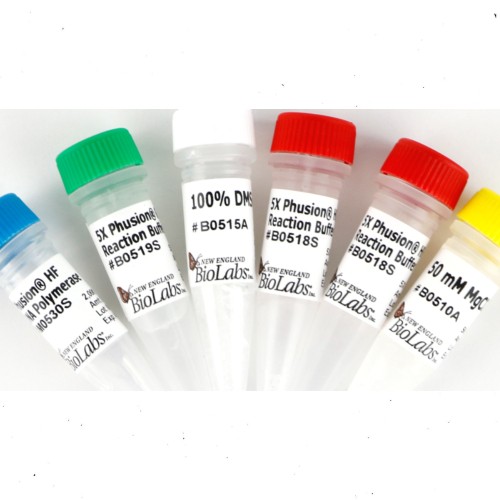
Phusion High-Fidelity DNA Polymerase
Brand:
New England Biolabs
For high speed and high performance PCR. Manufactured and quality-controlled at New England Biolabs, Thermo Scientific® Phusion High-Fidelity DNA Polymerase offers both high fidelity and robust performance.
- 50X higher fidelity than Taq
- Robust reactions – maximal success with minimal optimization
- Offered with multiple buffers for customized reaction setup for different DNA templates
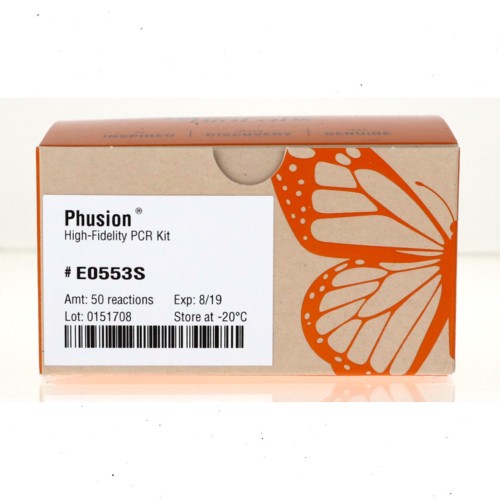
Phusion High-Fidelity PCR Kit
Brand:
New England Biolabs
Ideal for high speed and high-performance PCR. Manufactured and quality-controlled at New England Biolabs, Thermo Scientific®Phusion® High-Fidelity DNA Polymerase offers both high fidelity and robust performance.
- 50X higher fidelity than Taq
- Robust Reactions – maximal success with minimal optimization
- Kit includes everything needed for a PCR reaction, including controls

Phusion High-Fidelity PCR Master Mix with GC Buffer
Brand:
New England Biolabs
For high speed and high performance PCR. Manufactured and quality-controlled at New England Biolabs, Thermo Scientific® Phusion High-Fidelity DNA Polymerase offers both high fidelity and robust performance.
- 50X higher fidelity than Taq
- Robust reactions – maximal success with minimal optimization
- Master mix format with GC buffer ideal for long, difficult, or GC-rich DNA templates

Phusion High-Fidelity PCR Master Mix with HF Buffer
Brand:
New England Biolabs
For high speed and high performance PCR. Manufactured and quality-controlled at New England Biolabs, Thermo Scientific® Phusion® High-Fidelity DNA Polymerase offers both high fidelity and robust performance.
- 50X higher fidelity compared to Taq
- Robust reactions – maximal success with minimal optimization
- Master mix format with HF buffer ideal for a wide range of AT/GC content

Phusion Hot Start Flex 2X Master Mix
Brand:
New England Biolabs
For high speed and high performance PCR. Manufactured and quality-controlled at New England Biolabs, Thermo Scientific® Phusion High-Fidelity DNA Polymerase offers both high fidelity and robust performance.
- 50X higher fidelity than Taq
- Hot start formulation reduces non-specific amplification
- Master mix format for ease of use and optimized performance
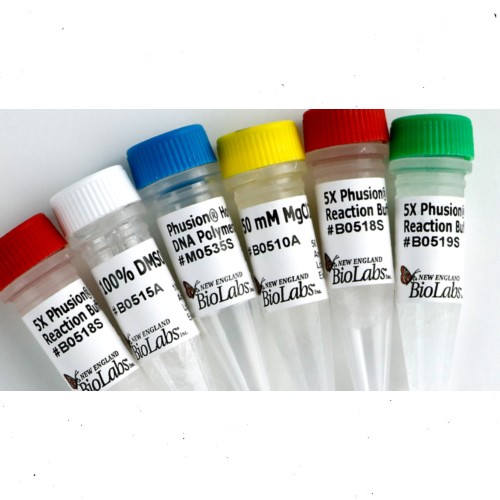
Phusion Hot Start Flex DNA Polymerase
Brand:
New England Biolabs
For high speed and high performance PCR. Manufactured and quality-controlled at New England Biolabs, Thermo Scientific® Phusion High-Fidelity DNA Polymerase offers both high fidelity and robust performance.
- 50X higher fidelity than Taq
- Robust reactions with minimal optimization
- Hot start formulation enables room temperature reaction setup and reduces non-specific amplification
- High yields with shorter extension times

Pip20 Pipemidic Acid
RM0.00Brand:
Thermo ScientificTM OxoidTM

Pipette Stand/Rack
RM0.00Brand:
Biologix
This item is not available at the moment. Please contact us for more information.
Characteristics
Holds up to six single- or multi-channel pipettes.


